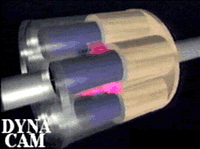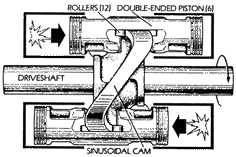|
|
|
||
|
|
|
||
|
|
design overview
The initial Dyna-Cam Engine to be manufactured and sold is rated at 200 hp. the engine is 13" in diameter, 40" long and weighs 300 pounds with basic accessories. It has unique features and major benefits over conventional engines of similar weight and power. the benefits include lower manufacturing costs in equal production, 50% smaller size, 50% fewer replacement parts, better fuel economy, smoother operation, lighter weight, plus nearly 100% higher torque enabling the engine to turn high efficiency propellers with lower noise output. the engine has two identical cylindrical blocks that each have six cylinders arranged parallel around the main shaft located in the center. Cylinders of both blocks line up so that six double-ended pistons can fire back and forth between the aligned cylinders of each block Each free floating piston is cut away on the central interior side and fits with precision around a 9" diameter, four lobe, sinusoidal cam that is keyed to the main shaft.
As the pistons fire back and forth, the main cam rolls through the pistons causing the central shaft to turn. all moving surfaces are roller bearing surfaces. another smaller 5" cam is attached to the main shaft at the outer end of each block. as each valve cam turns, it pushes against hydraulic lifters which push against the poppet valves inside each cylinder head. the engine is a 4-stroke engine. Because of the design of the main cam, each of the twelve cylinders fires with every revolution of the shaft, in contrast to three times with conventional six-cylinder engines. the engine can be described as a free piston, axially cam-drive engine.
External accessory systems manage air intake, fuel, oil flow, cooling and exhaust. all accessory systems operate similar to standard systems used on conventional engines and may be easily updated with the latest state-of-the-art technology. devices used on normal piston engines can be adapted to the dyna-Cam Engine for achieving the lowest possible emissions or higher power output, i.e. electronic ignition, state of the art emissions devices, or high tech fuel injection. higher torque at lower rpms and reduced internal friction allow more work to be accomplished by the dyna-Cam for the same measured quantity of fuel when compared to the conventional piston engine.
The functional and operational design of the dyna-Cam Engine is complete. Forty prototype units have been tested and rebuilt resulting in the final design that was certified. minor changes have been completed to expedite assembly and facilitate cost effective mass production. the first engines are now in production and purchase orders and down payments are being taken.
dynaCam home
product main
specifications
design overview
performance
advantages
assembly
r&d
dyno testing
torque vs. hp


